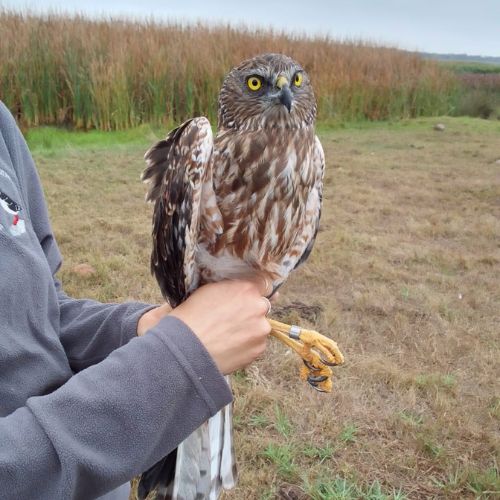
Each time a bird is carefully held in a ringer’s hand and fitted with a small, uniquely numbered metal band, a quiet story begins – one of understanding survival and adaptation.
Bird ringing, also known as bird banding, is far more than just a scientific practice; it’s a tool that unlocks secrets of the avian world, enabling us to better conserve the birds that not only occur locally, but also those that move between continents.
The Nuwejaars Wetlands Special Management Area (NWSMA) recently teamed up with the experts of the Biodiversity and Development Institute (BDI), to place rings on birds carefully caught in mist nets and spring traps baited with worms.
Dieter Oschadleus and Prof Les Underhill not only helped the NWSMA learn more about birds moving in our wetlands and our fynbos; they also trained volunteers and schoolchildren from local schools to take part in one of the most effective long-term ecological monitoring efforts. As a result, the NWSMA hosted birders from as far away as Germany, the Netherlands, Sweden and the UK, who popped over to the most southern-tip of Africa to collaborate with the South African ringers.
But what exactly do we learn from bird ringing
and why does it matter?
Mapping migration and movement
One of the most immediate benefits of bird ringing is understanding where birds go. Until the advent of satellite tracking, ringing was the primary way to map migration routes. Even today, it remains a vital, low-cost, and minimally intrusive way of tracking bird movements – especially for small species that are too light to carry GPS devices.
Interestingly, while we know much about intercontinental migration, we often lack insight into more localised movements. For example, between October to December, the NWSMA becomes a temporary home to White-throated Swallow, before they depart in March. But we still don’t know exactly where these birds spend the non-breeding season – somewhere in “central Africa” is about as precise as our current data gets, according to Prof Underhill.
Similarly, for the endemic Cape Sugarbird – which only occurs in the Cape Floral Kingdom and is a regular sighting in the NWSMA – ringing could help reveal how they navigate the fire-driven cycles of the fynbos biome and move between protea patches, especially when there is little food available.

Survival rates of birds
Ringing also provides critical insights into how long birds live. By recapturing or finding ringed birds over time, researchers can calculate survival rates. These stats can then be fed into conservation action plans. This is especially useful for the NWSMA, which highlights the protection of Species of Conservation Concern – like African Marsh Harrier – as a key objective.
During a recent visit, the BDI team, working with the NWSMA, captured 98 birds of 26 species. That included African Rail, African Snipe, Little Rush Warbler, Black Crake and Southern Grey-headed Sparrow.
Should any of these birds be caught again in future, it will not only provide data on how long the birds live, but also the age at which birds start breeding. If fledglings take several years to reach breeding age, then even a seemingly healthy population may be in decline. Ringing therefore allows us to close an essential data gap in population modelling.

Changing patterns as our climate changes
Ringers collect a range of biometric data – mass, wing and tail length, and moult stage (determined by the count of primary wing feathers) – while birds are in hand. In the NWSMA, the team also checked for a brood patch (or incubation patch – the patch of featherless skin on the underside of birds during the nesting season). In the case of birds that do not often get caught, like African Rail and Black Crake, additional measurements were taken.
These measurements, when pooled across large datasets, reveal patterns of seasonal fattening, migration timing and the wear and renewal of feathers.
This kind of long-term monitoring is crucial. At ringing stations in Europe, decades of data have revealed that birds like the Willow Warbler are migrating earlier each year – likely due to climate change. Similar insights could emerge from consistent ringing in the Nuwejaars Wetlands, helping South Africa play a global role in understanding environmental change.

Bringing together people who care
Perhaps the most powerful part of bird ringing is its people. Through courses like those run by the BDI, more people are gaining the skills needed to contribute valuable data to global databases. So too the schoolchildren who experienced bird ringing during our NWSMA Environmental Education Programme, could be inspired to enter careers in conservation.
Each ringed bird is not just a data point – but also a story. A ringer who retraps a bird ringed a decade earlier holds in their hand a testament to survival. A swallow that flew thousands of kilometres. A wader that weathered decades of storms. A sugarbird adapting to a landscape shaped by fire.
Bird ringing reminds us that birds are not just fleeting visitors. They are part of intricate systems that span continents and generations. By understanding their stories, we learn to better protect our world.

Sources: The value of bird ringing to research and conservation, by Prof Les Underhill: The BDI
